Escape to L.A., rev. ed.
 fig. a: L.A. by night
fig. a: L.A. by night
It took about 18 hours, but, suddenly, there I was, in Downtown L.A.
 fig. b: continental divide
fig. b: continental divide
I'd had a particularly scenic transcontinental flight, one that provided stunning views of the Rockies, and an equally stunning sunset descent over L.A. county and into LAX.
 fig. c: Standing Rib, 1962
fig. c: Standing Rib, 1962
I didn't fully realize it at the time, but a print by Roy Lichtenstein that I saw in the Museum of Contemporary Art's 30-year retrospective on my first day in L.A. proved to be emblematic, as you'll see.
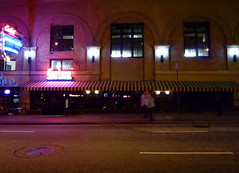 fig. d: Cole's by night
fig. d: Cole's by night
For my very first meal, I walked from my hotel on South Grand to Cole's on 6th to have my very first authentic L.A. French Dip sandwich. Cole's is one of the two Downtown L.A. establishments that claims to have invented the French Dip sandwich over a century ago now, back in 1908.
 fig. e: Cole's by Cole's
fig. e: Cole's by Cole's
Cole's is definitely the hipper of the two, and the joint was jumping when I arrived: the stereo was cranked up, the drinks were flowing, and the crowd was young and happening. Despite their insistence that the City of Los Angeles authenticated their claim to being the "originators of the French dip" back in the 1970s, Cole's definitely comes across as the challenger at the moment. This isn't a bad thing. It's made them hungrier to assert themselves. So the place was given a loving restoration a few years ago. And they also picked up an executive chef. But, more importantly, it's made them very assertive with their menu. Their house mustard is a potent, horseradish-laced, "Atomic" concoction. Their pickles are homemade, half-sour, and chili-laced--not for the faint of heart. They, too, have been given the (well-deserved) "Atomic" moniker. Their beef French dip sandwich is a hefty, freshly carved number that comes with the jus served demurely on the side. In other words, here you dip the sandwich yourself, according to your whims. Beer selection is good, with three Germans (Bitburger, Spaten, and Franziskaner) and Anchor Steam (on tap) being among the highlights. The bar is an early-20th-century classic and it's fully loaded to boot.
 fig. f: neon market
fig. f: neon market
The Grand Central Market has been a Downtown L.A. institution for roughly 90 years now. My camera might have been attracted to the China Cafe and its iconic, Edward Hopper-esque
CHOW MEIN
sign, but I was on the prowl for tacos--fish tacos, quite specifically--so I made a beeline to Maria's Fresh Seafood. The majority of my compadres were having seafood caldos, and they looked and smelled delicious, but I went with the fish taco special: two fish tacos, salad, salsa, crema, beans, and rice, all for a fiver. So simple, so satisfying, so good.
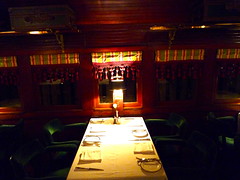 fig. g: all aboard!
fig. g: all aboard!Later that day was the splurge of the trip: dinner for three at the Pacific Dining Car. At 89 years old, the Pacific Dining Car is another venerable L.A. institution. The Pacific Dining Car has a reputation for being one of the city's finest steakhouses, but it's also known for its main dining room, which simulates the interior of an early-20th-century railway dining car, as well as its associations with the writer James Ellroy. The Pacific Dining Car is something of an anomaly among high-class restaurants: it's open 24 hours a day, 365 days a year, and it has a special late-night menu that's made it popular with the city's nighthawks. Dinner consisting of a 16-ounce ribeye (cooked a perfect medium-rare), creamed spinach, a salad, a nice bottle of wine, and some impeccable service was pricey, but, man, did it ever hit the spot. The only disappointment: no sign of the "demon dog of American crime fiction."
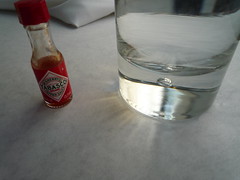 fig. h: the big and the small 1
fig. h: the big and the small 1Bottega Louie is an oddly named restaurant with a choice Downtown location, a fancy Italian pizza oven, a full-size, open-format kitchen, an open-format pastry kitchen, a bar/café area, a massive, sprawling floor plan, towering 50-foot ceilings, and a veritable army of waitstaff. How they've managed to survive the Great Recession, I have no idea. Must have something to do with their appealing menu, because Bottega Louie is packing 'em in. I was so overwhelmed by the immensity of the operation, that the only photograph I took was of the miniature Tabasco sauce bottle that came with my brunch.
The brunch menu had so many tantalizing options that I actually had a hard time making a selection. I ended up settling on the scrambled eggs with burrata, pancetta, caramelized cippolini onions, and oyster mushrooms, and I was happy I did.
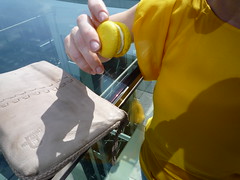 fig. i: étude en jaune
fig. i: étude en jauneBottega Louie's pastry division specializes in macarons. Our favorite was the lemon, which also made for a good photograph.
 fig. j: Park's by Park's
fig. j: Park's by Park'sBetween Saveur's Los Angeles issue and my friend MS's 411, I had more Koreatown tips than I knew what to do with. Never did get around for going for KFC (Korean fried chicken), but I did make it out for Korean BBQ with a gang of fellow travelers. We could see and smell all kinds of delicacies as we waited to be seated. (Actually, the wonderful aromas began from the moment we got out of our taxi.) But Park's marbled short ribs looked particularly tantalizing and came highly recommended. In addition to the short ribs, we ordered marinated shrimp and bulgogi. Later, I was kicking myself for not ordering the pork belly, which got raves in Saveur. There was a moment there, right after we ordered, when we panicked, thinking we needed to order some vegetables to go along with all that meat. Then I realized, this is a Korean BBQ restaurant--the condiments are coming. In fact, the folks at Park's covered our table with more condiments than I've ever seen. And seconds later the first of our mains--the short ribs--were sizzling away on our tables built-in grill. From the moment we wrapped our first lettuce leaves and rice wrappers around those tender morsels of meat smothered in Korean pickles of all sorts, we were hooked.
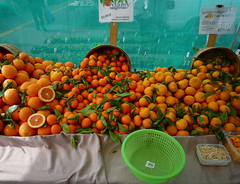 fig. k: orange, bowl
fig. k: orange, bowlComing from the relative deprivation of Canada in late-winter, the Hollywood Farmers' Market was a vision of plenitude that I found a bit overwhelming. Just the citrus alone was more than I could handle. All those varieties of oranges, tangerines, grapefruit, and lemons, all ripe and sweet and bursting with flavor. The daisy tangerines, in particular, tasted like nectar. Then there were the nuts--pistachios and almonds, in particular. And the dried fruit, including Mission figs the likes of which I'd never had before. And then there was all the stuff I couldn't even bear to look at--fruits, vegetables, herbs, cheeses, etc.--seeing as I was going to be back on a plane 12 hours later. What I did take advantage of were the tamales with green chiles, ricotta, and queso, and a rich, expertly made macchiato from Cafécito Organico, who have a shop in Silver Lake, but who go to the trouble of setting up an espresso machine on wheels, as it were, at the market. Ah, California!
 fig. l: showtime!
fig. l: showtime!Buzzing with vitamin C and high on caffeine, I made my way into Hollywood. The L.A. Marathon was on and the tail end of the pack was making its way down Hollywood Boulevard, so the streets were closed off to anything but pedestrian traffic.
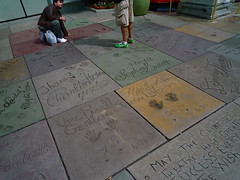 fig. m: transference
fig. m: transferenceI checked out a few Hollywood pilgrimage points, like the Egyptian/American Cinémathèque and Musso & Frank's Grill, and when I got to Grauman's Chinese Theater I witnessed a peculiar act of transference: a man was posing for a photograph in the Forecourt of the Stars, his hand placed carefully in Al Pacino's handprint.
 fig. n: burger by Umami Burger
fig. n: burger by Umami BurgerA couple of hours later, I'd made my way back to Space 15Twenty, adjacent to the Hollywood Farmer's Market, so that I could experience my very first Umami Burger. I considered having the signature Umami Burger, with its famed "umami x 6" flavor explosion, and I contemplated the SoCal Burger, with butter lettuce, oven-dried tomato spread, house-made American cheese, and caramelized, but ultimately I went with the Hatch Burger, which marries 4 different types of roasted green chiles with UB's house cheese. I'm happy to say that Umami Burger's Hatch Burger lived up to all expectations (and with all the hype surrounding UB these days, expectations were high). The patty was gigantic, tender, barely holding together, nice and rare, and juicy as all get-out. The bun was simple, but fresh, toasted, and tasty, and perfectly capable of holding the contents together. The toppings were dreamy. I ate the whole thing in about 32.3 seconds, and that was only because I made a conscious effort to "take my time." I had to restrain myself from ordering a second burger for dessert.
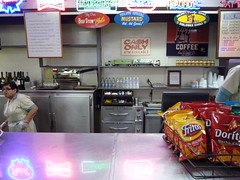 fig. o: the big and the small 2
fig. o: the big and the small 2Just when you thought I couldn't possibly eat any more beef on a 3-day furlough, I closed out my all-too-brief culinary tour of Los Angeles with a trip to Philippe's to try out their interpretation of the French Dip sandwich. Yes, Philippe's is the other Downtown L.A. establishment that claims to have invented the French Dip or French-dipped sandwich back in 1908, the place the folks at Cole's refer to as "that other downtown sandwich shop." Philippe's functions counter-style, they have sawdust on the floor, they house a satellite exhibit of the Los Angeles Railroad Heritage Foundation in their back room, and they serve their sandwiches pre-dipped (to order). The vibe is both more family-friendly and more old-school than Cole's; it's not nearly as hip. Philippe's mustard may not be "atomic," but, by God, it too is "hot... but good!" And their French-dipped beef sandwich was delicious--a little messier than their competitor's, perhaps, but it didn't last long enough to become an issue. I'm not one to waffle when it comes to these kinds of debates--I tend to have strong opinions about such things--but, I have to say: I liked them both, they both had their charms. And, to be honest, I don't really care who the true originator is. I'm not an Angeleno, so I'm not all that invested in the issue. I'm just glad they're both still around, still a vital part of L.A.'s downtown dining scene over 100 years after they first opened their doors.
I really didn't intend for my Escape to L.A. to turn into a 3-day beef binge (with just a couple brief interludes), but sometimes you just gotta go with the flow. Plus, maybe this is could be the beginning of a themed series on L.A. Here's hoping. Think of the possibilities: L.A. Pork, L.A. Fish, L.A. Vegetables, L.A. Bread...
Addendum:
 fig. p: chocoholics, report!
fig. p: chocoholics, report!If you're in Los Angeles in the next little while, do make a point of visiting the Museum of Contemporary Art's phenomenally rich and varied "Collection: MOCA's First 30 Years." Not only will you get to see Lichtenstein's Standing Rib, alongside works by Warhol, Arbus, Frank, Stella, Levitt, Rauschenberg, Matta-Clark, Goldin, Judd, Smithson, Baltz, Berman, and many, many others, but you'll have the opportunity to immerse yourself in the considerable sensorial pleasures of Ed Ruscha's Chocolate Room (yes, that's actual chocolate lining the walls).
 fig. q: the gang's all here!
fig. q: the gang's all here!And if you're already Downtown, and you're something of a film buff, you might want to pop in to the Biltmore Hotel to visit their gallery of photographs documenting the many Academy of Motion Picture Arts and Sciences awards ceremonies that were held there between the early 1930s and the early 1940s.
Cole's, 118 East 6th Street, Los Angeles (Downtown), (213) 622-4090
Maria's Fresh Seafood, Grand Central Market, 317 S. Broadway, Los Angeles (Downtown), (213) 624-2378
Pacific Dining Car, 1310 West 6th Street, Los Angeles (Downtown), (213) 483-6000
Bottega Louie, 700 South Grand Avenue, Los Angeles (Downtown), (213) 802-1470
Park's BBQ, 955 South Vermont Avenue, Los Angeles (Koreatown), (213) 380-1717
Hollywood Farmers' Market, Ivar & Selma Avenue, Los Angeles (Hollywood), (323) 463-3171
Umami Burger, 1520 North Cahuenga Blvd., Los Angeles (Hollywood), (323) 469-3100 [with other locations on South LaBrea and on Hollywood Blvd.]
Philippe's, a.k.a. Philippe The Original, 1001 North Alameda St., Los Angeles (Downtown), (213) 628-3781
aj











